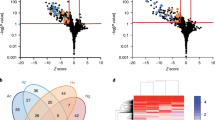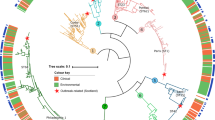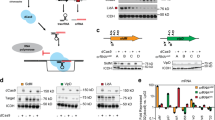Abstract
In inbred mouse strains, permissiveness to intracellular replication of Legionella pneumophila is controlled by a single locus (Lgn1), which maps to a region within distal Chromosome 13 that contains multiple copies of the gene baculoviral IAP repeat–containing 1 (Birc1, also called Naip; refs. 1–3). Genomic BAC clones from the critical interval were transferred into transgenic mice to functionally complement the Lgn1-associated susceptibility of A/J mice to L. pneumophila. Here we report that two independent BAC clones that rescue susceptibility have an overlapping region of 56 kb in which the entire Lgn1 transcript must lie. The only known full-length transcript coded in this region is Birc1e (also called Naip5).
This is a preview of subscription content, access via your institution
Access options
Subscribe to this journal
Receive 12 print issues and online access
$209.00 per year
only $17.42 per issue
Buy this article
- Purchase on SpringerLink
- Instant access to full article PDF
Prices may be subject to local taxes which are calculated during checkout





Similar content being viewed by others
References
Yoshida, S., Goto, Y., Mizuguchi, Y., Nomoto, K. & Skamene, E. Genetic control of natural resistance in mouse macrophages regulating intracellular Legionella pneumophila multiplication in vitro. Infect. Immun. 59, 428–432 (1991).
Diez, E. et al. Genetic and physical mapping of the mouse host resistance locus Lgn1. Mamm. Genome 8, 682–685 (1997).
Growney, J.D. & Dietrich, W.F. High-resolution genetic and physical map of the Lgn1 interval in C57BL/6J implicates Naip2 or Naip5 in Legionella pneumophila pathogenesis. Genome Res. 10, 1158–1171 (2000).
McDade, J.E. et al. Legionnaires' disease: isolation of a bacterium and demonstration of its role in other respiratory disease. N. Engl. J. Med. 297, 1197–1203 (1977).
Horwitz, M.A. & Silverstein, S.C. Legionnaires' disease bacterium (Legionella pneumophila) multiples intracellularly in human monocytes. J. Clin. Invest. 66, 441–450 (1980).
Swanson, M.S. & Isberg, R.R. Association of Legionella pneumophila with the macrophage endoplasmic reticulum. Infect. Immun. 63, 3609–3620 (1995).
Yamamoto, Y., Klein, T.W., Newton, C.A. & Friedman, H. Interaction of Legionella pneumophila with peritoneal macrophages from various mouse strains. Adv. Exp. Med. Biol. 239, 89–98 (1988).
Yamamoto, Y., Klein, T.W., Newton, C.A., Widen, R. & Friedman, H. Growth of Legionella pneumophila in thioglycolate-elicited peritoneal macrophages from A/J mice. Infect. Immun. 56, 370–375 (1988).
Beckers, M.C., Yoshida, S., Morgan, K., Skamene, E. & Gros, P. Natural resistance to infection with Legionella pneumophila: chromosomal localization of the Lgn1 susceptibility gene. Mamm. Genome 6, 540–545 (1995).
Scharf, J.M. et al. The mouse region syntenic for human spinal muscular atrophy lies within the Lgn1 critical interval and contains multiple copies of Naip exon 5. Genomics 38, 405–417 (1996).
Endrizzi, M.G., Hadinoto, V., Growney, J.D., Miller, W. & Dietrich, W.F. Genomic sequence analysis of the mouse Naip gene array. Genome Res. 10, 1095–1102 (2000).
Diez, E., Yaraghi, Z., MacKenzie, A. & Gros, P. The neuronal apoptosis inhibitory protein (Naip) is expressed in macrophages and is modulated after phagocytosis and during intracellular infection with Legionella pneumophila. J. Immunol. 164, 1470–1477 (2000).
Growney, J.D., Scharf, J.M., Kunkel, L.M. & Dietrich, W.F. Evolutionary divergence of the mouse and human Lgn1/SMA repeat structures. Genomics 64, 62–81 (2000).
Holcik, M. et al. The hippocampal neurons of neuronal apoptosis inhibitory protein 1 (NAIP1)-deleted mice display increased vulnerability to kainic acid- induced injury. Proc. Natl. Acad. Sci. USA 97, 2286–2290 (2000).
Wright, E.K. et al. Naip5 affects host susceptibility to the intracellular pathogen Legionella pneumophila. Curr. Biol. 13, in the press (2003).
Roy, N. et al. The gene for neuronal apoptosis inhibitory protein is partially deleted in individuals with spinal muscular atrophy. Cell 80, 167–178 (1995).
Somerville, M.J. et al. Clinical application of the molecular diagnosis of spinal muscular atrophy: deletions of neuronal apoptosis inhibitor protein and survival motor neuron genes. Am. J. Med. Genet. 69, 159–165 (1997).
Haider, M.Z., Moosa, A., Dalal, H., Habib, Y. & Reynold, L. Gene deletion patterns in spinal muscular atrophy patients with different clinical phenotypes. J. Biomed. Sci. 8, 191–196 (2001).
Liston, P. et al. Suppression of apoptosis in mammalian cells by NAIP and a related family of IAP genes. Nature 379, 349–353 (1996).
Hozak, R.R., Manji, G.A. & Friesen, P.D. The BIR motifs mediate dominant interference and oligomerization of inhibitor of apoptosis Op-IAP. Mol. Cell. Biol. 20, 1877–1885 (2000).
Wu, G. et al. Structural basis of IAP recognition by Smac/DIABLO. Nature 408, 1008–1012 (2000).
Koonin, E.V. & Aravind, L. The NACHT family—a new group of predicted NTPases implicated in apoptosis and MHC transcription activation. Trends Biochem. Sci. 25, 223–224 (2000).
Perrelet, D. et al. IAP family proteins delay motoneuron cell death in vivo. Eur. J. Neurosci. 12, 2059–2067 (2000).
Maier, J.K. et al. The neuronal apoptosis inhibitory protein is a direct inhibitor of caspases 3 and 7. J. Neurosci. 22, 2035–2043 (2002).
Gao, L.Y. & Abu Kwaik, Y. Apoptosis in macrophages and alveolar epithelial cells during early stages of infection by Legionella pneumophila and its role in cytopathogenicity. Infect. Immun. 67, 862–870 (1999).
Muller, A., Hacker, J. & Brand, B.C. Evidence for apoptosis of human macrophage-like HL-60 cells by Legionella pneumophila infection. Infect. Immun. 64, 4900–4906 (1996).
Watarai, M. et al. Legionella pneumophila is internalized by a macropinocytotic uptake pathway controlled by the Dot/Icm system and the mouse Lgn1 locus. J. Exp. Med. 194, 1081–1096 (2001).
Yaraghi, Z., Korneluk, R.G. & MacKenzie, A. Cloning and characterization of the multiple murine homologues of NAIP (neuronal apoptosis inhibitory protein). Genomics 51, 107–113 (1998).
Endrizzi, M. et al. Comparative sequence analysis of the mouse and human Lgn1/SMA interval. Genomics 60, 137–151 (1999).
Acknowledgements
The authors thank A. MacKenzie and D. Malo for their help and support, N. Gendron and J. Penney for expert technical assistance, members of the McGill Mouse Genetics Group for use of the BAC transgenic core and L. Simard and C.J. DiDonato for BAC clone 227n6. This work was supported by grants from the Network of Centers of Excellence (Canadian Genetic Diseases Network) to P.G. P.G. is supported by a Distinguished Scientist award and E.D. by a studentship from the Canadian Institutes of Health Research. The BAC transgenic core was supported by a grant from Innovation Quebec.
Author information
Authors and Affiliations
Corresponding author
Ethics declarations
Competing interests
The authors declare no competing financial interests.
Rights and permissions
About this article
Cite this article
Diez, E., Lee, SH., Gauthier, S. et al. Birc1e is the gene within the Lgn1 locus associated with resistance to Legionella pneumophila. Nat Genet 33, 55–60 (2003). https://doi.org/10.1038/ng1065
Received:
Accepted:
Published:
Issue Date:
DOI: https://doi.org/10.1038/ng1065



